15 Great Games to Improve Hand-Eye Coordination for Developmental Delay
Hand-eye coordination is the relationship between what we see and how we use our hands. This skill is developed through practice and is essential for every-day tasks such as dressing, eating and playing.
Below we share some of our favourite activities to improve hand-eye coordination.
The ideas are sequenced by difficulty: starting with the least demanding activities and progressing through to the most challenging. Where we start depends on our child’s ability: we should choose an activity they will be successful at but that will still offer a challenge.
Read the advice about getting the most out of these activities before giving them a go.
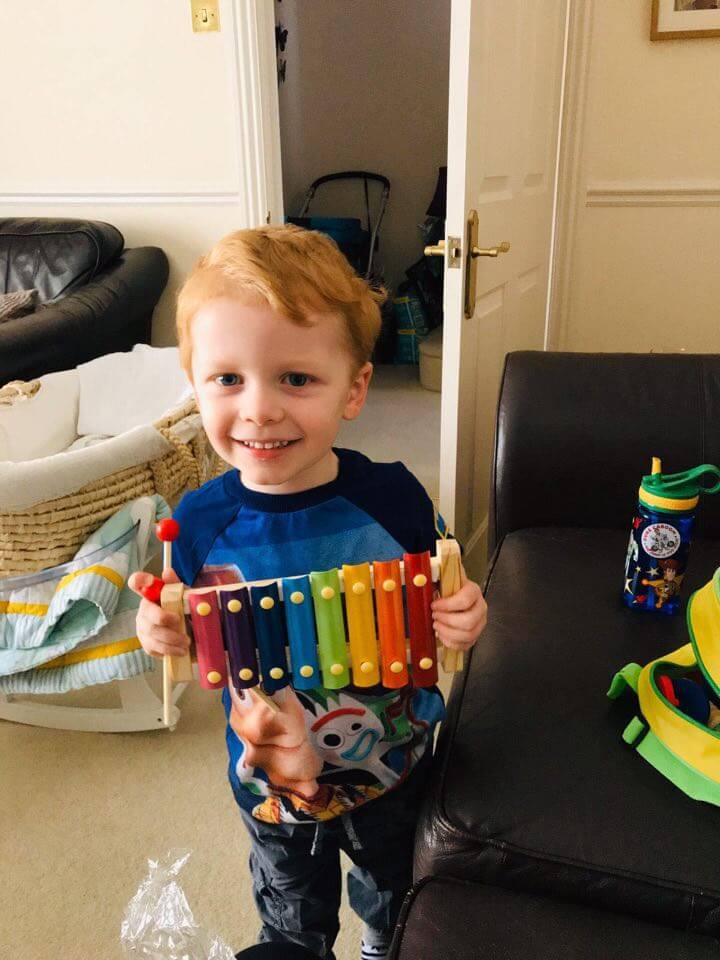
Before trying these exercises, take a minute to prepare your child – they will feel the benefit!
To wake up their muscles, squeeze their hands, tips of their fingers and their arms. You could also use a brush along their skin, or a vibrating massager. All of these will increase your child’s awareness of their body, helping them be
more accurate and learn more effectively. It will also increase their enjoyment of the activity.Wherever possible, encourage two handed play – it is fantastic for brain development. Crossing hands across the middle of their body will be useful too.
Make sure your child is successful in their game as this will motivate them to continue. As you push them to get to the next level, they should be able to manage a few of their attempts to stay motivated – even if they are not successful every time.
Remember to praise the effort made rather than the result achieved. This motivates your child to keep putting in effort and not be put off if they don’t succeed at first.
Playing with musical toys is a great way to build hand-eye coordination. Beating a drum, hitting a bell or pushing notes on a keyboard all help develop the skill.
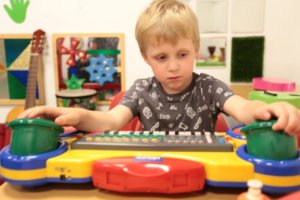
- If you don’t have any instruments at home you can use everyday objects like a wooden spoon and upside down saucepan as a drum, or a plastic bottle with some rice in it as a rattle. Silver foil is great to scrunch.
- This blog shares some other ideas for making instruments using everyday objects in the home.
- To build accuracy using musical instruments, invite your child to play a ‘Simon Says’ music game. Play a simple beat/tune on an instrument and challenge your child to copy it. Then they can create a beat/tune for you to copy.
There are some fabulous apps for tablets which require very little movement to get a big effect. When our children can see that their hand movements create big visual results, they will be more motivated to use their hands. This is the first step in developing hand eye coordination.
Here are some apps to try:
Sensory Light box or Sensory Soundbox (£2.99 each from Apple or Android). Just a touch on the screen produces a wide variety of sounds and noises. As you move your fingers/hand the noises change. Very calming or stimulating, depending on the setting and wonderful feedback for cause and effect.
 Fluidity HD (free – for Apple devices only). Beautiful flowing colours controlled by any touch on the screen.
Fluidity HD (free – for Apple devices only). Beautiful flowing colours controlled by any touch on the screen.Baby’s Musical Hands (free – for Apple and Android). Musical and colourful app – any touch will play a piano sound.
Finger paint (free for Apple and Android). Opportunity to paint with different colours and sounds. User can use multiple fingers at a time to paint, which is great for those who struggle to isolate a single finger.
Duck Duck Moose nursery rhymes series (free on Apple and Android). These are a series of apps with entertaining and often surprising cause and effect options which can keep your younger child (and you) entertained for ages. We particularly like Itzy Bitsy HD, Old Mac HD and Trucks HD.
 Dr Panda series (Apple and Android, vary from free to up to £3.99) has some lovely options with simple yet entertaining games for young children. We enjoy Dr Panda Restaurant, Hospital, Beauty Salon and Daycare.
Dr Panda series (Apple and Android, vary from free to up to £3.99) has some lovely options with simple yet entertaining games for young children. We enjoy Dr Panda Restaurant, Hospital, Beauty Salon and Daycare.
Start by blowing bubbles and catching them with the bubble wand. Bring the wand closer to your child and see if they can pop the bubble. If your child can’t use a pointer finger they can just use their whole hand.
Move the wand around so that they are reaching to pop in different directions.
When they are moving their arms to meet the wand, start blowing the bubbles into the air close to the child so that small movements of their arms will pop the bubbles.
Move on to blowing fewer bubbles so your child is encouraged to be more accurate with their popping.
Roll a ball between you and your child. Start with a big ball and get smaller as your child improves.
Encourage your child to try and stop the ball when it comes to them before rolling back.
Try rolling with more accuracy – e.g. into a upturned container.
Try stopping the ball with two hands
Try stopping the ball with one hand.
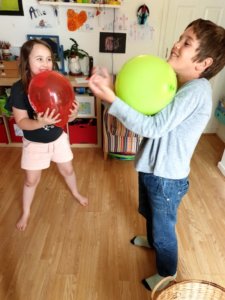
Staying nice and close to each other on the floor, roll a balloon to your child and ask them to hit it back. This is great for cause and effect as little effort goes a long way and the balloon moves slowly so gives more time to aim the hit back.
As your child improves, sit further apart and launch the balloon into the air rather than along the floor.
Set up a wobble board using a tray and a bottle or rolling pin.
This video shows you how to play this great hand-eye coordination game.
Use a beanbag or soft toy to practice throwing. Start with a big container or target very close to your child.
As your child gets more accurate, move the container further away.
You could encourage your child throw different items into different containers. This could be sorted by colour (e.g. green toys into the bucket, red toys into the laundry basket), or another category (e.g. dinosaurs through the hoop, farm animals into the saucepan).
Set up a Ten-pin bowling set with empty plastic bottles/toilet roll inners or stack a pyramid of empty tins.
Start very close to the target.
Give the child a large soft ball or soft toy to throw.
You could set up a ramp (a piece of cardboard, tray or cushion) to help them.
Encourage them to get more accurate by seeing how many throws it takes to knock them all over.
As your child gets more accurate, move the target further away.
You can also use a points system in a target game. Draw a target on some cardboard, put a points value on the different section and fix it to the door or on the floor. Encourage your child to throw a ball/toy at it and see how many points they can score in five throws. Then see if they can beat their score.
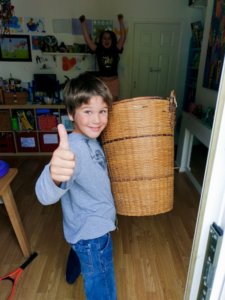
Give your child a bucket. This could rest on the floor or be held in their arms.
Throw a beanbag or other soft toy into the air and they need to move the bucket to catch it.
As they improve, make the bucket or container smaller so they have to increase their accuracy.
You could also make the ball small or harder for an extra challenge.
Start with a big soft ball and standing/ sitting very close together. Roll the ball into the child’s hands so they get used to holding it and balancing the ball between two hands.
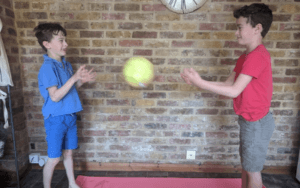 Ask the child to throw it back and keep practising until they are accurate to you at a very small distance.
Ask the child to throw it back and keep practising until they are accurate to you at a very small distance. Start moving back a little so there is a gap between you.
Start making the ball a bit smaller-soft balls and beanbags are easier to catch than fully inflated balls. If you don’t have balls at home use rolled up socks, small cushions or soft toys.
Move onto large inflated balls such as footballs and then try with smaller balls
Progress from two handed catches onto onw handed catches
Try also catching on their own-throwing into the air or against a wall.
Try moving further apart from each other one step at a time to increase the challenge.
- Here is a lovely video for more advanced throw and catch against the wall:
Create a ‘Juggle-board‘
You can use a flat clothes airer to create a board which enables you and your child to share a adapted ‘juggling’ experience together.
To play, rest a ball at one side of the airer, and use your hands to roll it between you and your child. The struts of the airier will act as ‘tracks’ that keep the ball rolling in a straight line.
To build the challenge, add another ball, and roll it so that one starts before or after the other. Try rolling the balls at the same time at different speeds.
Try sending ball across the board with opposite hands. You could ring a bell or make a sound effect when the ball has reached its destination.
Introduce a slow piece of music and try to pass the ball on the beat of 1, 4 or 8. See our video for details of how to set this up.
The progression to this is juggling with just one hand, and then eventually juggling with three balls for the ultimate in hand-eye coordination.
You can also watch our ‘Our Home’ video on how to make your own juggling balls here:
Start with ‘posting’ soft toys or larger balls into an open container.
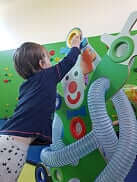
Progress to smaller toys into a smaller container. You could combine this with a matching game – putting the red objects into the red container etc.
Shape sorter games are fantastic for eye hand coordination. If you don’t have any, cut a hole in the lid of a plastic pot and post small objects.
As your child gets more accurate, cut smaller holes or slits and post smaller objects such as coins, pebbles or buttons.
You could cut different sizes of slits for different sizes of objects so they have to work our sizes as they post.
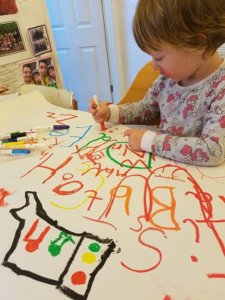 Use finger paints to start getting cause and effect and develop hand coordination. Start with lines up and down and side to side before trying to go diagonal and lastly to get circles (which are more complex).
Use finger paints to start getting cause and effect and develop hand coordination. Start with lines up and down and side to side before trying to go diagonal and lastly to get circles (which are more complex).In messy play this is good opportunity to make trails with fingers, follow lines, manoeuvre objects around etc. See messy play for ideas.
Move onto using brushes, crayons or pencils.
See our ‘fine motor skills’ section for more details of how to encourage drawing and painting.
Puzzles are lovely for making children match up shapes. Some children will try to use force instead of turning the puzzle piece to make it fit so start with easy puzzles where they can be more successful to teach theme about turning the puzzle piece (or turning the board if they can’t turn their hand as well).
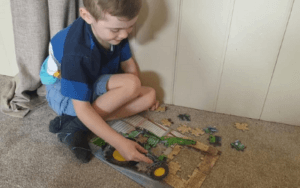 Puzzles with pegs on them are often the best place to start if children don’t have full hand control.
Puzzles with pegs on them are often the best place to start if children don’t have full hand control. Move onto regular flat puzzles as skills improve.
Use smaller pieces as skills improve.
If you don’t have puzzles at home, find a good picture from a magazine. Cut it into large or smaller pieces which your child can then piece back together.







